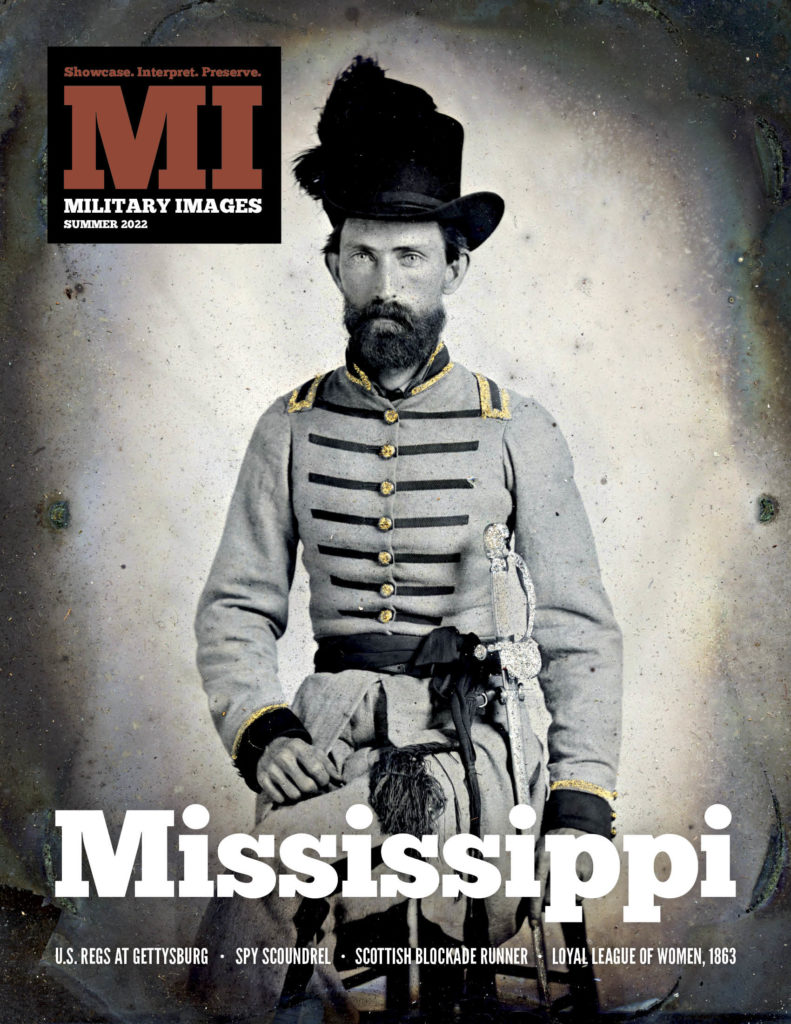A complete table of contents for the Summer 2022 issue of Military Images magazine, and information about how to purchase single issues and subscriptions.
Vol. XL, No. 3
(80 pages)
Print edition: Visit our store to check availability
Digital edition: Visit JSTOR.org to purchase
Subscribe to MI
Explore the MI Archives:
Browse | Advanced search | Tutorial
Inside
Cover image
A quarter-plate ambrotype from the Mathew L. Oswalt M.D. Collection of pictures a Mississippi soldier.
Table of Contents (p. 1)
Editor’s Desk (p. 2)
Can an original Civil War photograph become a non-fungible token (NFT)? Should it? The editor created one in an effort to answer these questions.
Mail Call (pp. 3-4)
Feedback includes information about Missouri’s Schofield Hussars and notice of the passing of Cary Delery, longtime proprietor of The Historical Shop.
Military Anthropologist (p. 4)
A survey of 869 identified Civil War military portraits reveals that ambrotypes dominate in the South, and cartes de visite were most popular in the North.
Passing in Review (pp. 6-8)
Bill Hendrick reviews Ends of War: The Unfinished Fight of Lee’s Army after Appomattox by Caroline E. Janney (University of North Carolina Press).
Photo Sleuth by Kurt Luther (pp. 10-12)
The National Portrait Gallery’s Civil War collection includes an image of three unidentified U.S. officers. The author investigates and identifies them.
Antebellum Warriors (p. 14)
A daguerreotype of a soldier ornately dressed in gold braid reminds one of “Old Fuss and Feathers,” Winfield Scott. He may be a photographer-militia officer.
Most Hallowed Ground (p. 16)
Artworks picturing David Farragut lashed to Hartford’s rigging at Mobile Bay are accurate. The man who secured him is profiled here: John Crittenden Watson.
The Honored Few (p. 18)
Edward Washburn Whitaker of the 1st Connecticut Cavalry received a Medal of Honor for an 1864 act of courage, but it best know for Appomattox.
The Citizenry by Elizabeth A. Topping(p. 20)
In “Heroines of the Hearth,” the author pays tribute to women who contributed in many ways to support the troops and the country during the Civil War.
Fakes, Forgeries and Frauds by Perry M. Frohne (pp. 22-23)
Results of our “Fake Radar Contest” — a chance to test your knowledge of fake cartes de visite and win a prize!
Mississippi Faces: Portraits from the Matthew L. Oswalt, M.D., Collection (pp. 24-37)
Representative portraits and stories of Mississippi men who served in the Confederate army and fought in the Eastern and Western Theaters of the Civil War.
A Scottish Blockade Runner: The life and times of Joannes Wyllie, commander of the Ad-Vance by John F. Messner (pp. 38-41)
Much is known about the exploits of the blockade runner Ad-Vance, but very little about its captain, Joannes Wyllie — until now.
“How They Went Forth to the Harvest of Death”: A concise account of the U.S. Regular Infantry at Gettysburg by Charles T. Joyce, featuring images from the author’s collection (pp. 43-51)
The story of the diehard U.S. Regulars at the Battle of Gettysburg has been largely overlooked. This account reveals the trials and tribulations they endured.
Under the Banner of Emancipation and National Unity: The Woman’s National Loyal League and the call to political activism by Ronald S. Coddington, featuring an image from the Mike Werner Collection (pp. 52-57)
In 1863, loyal Union women led by Susan B. Anthony and Elizabeth Cady Stanton formed a new organization to support the war and lobby for a human rights agenda.
Scoundrel: The rise and fall of Union spy chief Lafayette Curry Baker by David B. Holcomb (pp. 59–67)
Lafayette C. Baker’s journey took him from San Francisco vigilante to Allen J. Pinkerton adversary to controversial spy chief and captor of Booth. His story.
Behind the Overlooked Stories of the Untold Civil War: Q@A with Paul Hoza (pp. 69-71)
The host of the popular podcast Untold Civil War talks about his fascination with history, the 79th New York Highlanders, and his media journey.
Material Culture by Frank Graves (p. 72)
The Walch Navy revolver is a rarity. By one estimate, only 200-300 were produced. Images of soldiers armed with the weapon are equally as rare. Here’s one.
Behind the Backdrop: Origins, artistry and photographers by Adam Ochs Fleischer (pp. 74-75)
In “House Near the Susquehanna,” Fleischer examines the distinctive painted canvas featured in photographs by Kern & Gaugler of Selinsgrove, Pa.
Vignette By Scott Valentine (p. 76)
In “Alone in His Glory,” we meet Lt. Col. Henry H. Pearson of the 6th New Hampshire Infantry. He made the ultimate sacrifice at Petersburg in 1864.
Stragglers (p. 78)
Portraits of a Texas officer, a Modoc War veteran, and a rare late Civil War daguerreotype of a U.S. soldier wearing a corps badge on his cap.
The Last Shot (p. 80)
Hardtack and coffee were standard fare for most U.S. soldiers in the Civil War — and the subject of ridicule to weary troops craving a varied diet.




































[…] “How They Went Forth to the Harvest of Death” by Charles T. Joyce is a concise account of the diehard U.S. Regulars at the Battle of Gettysburg, a story largely overlooked in the annals of the war. Chuck reveals the trials and tribulations they endured, and illustrates the story with images from his collection, which is focused on portraits of Gettysburg participants. The story appeared in our Summer 2022 issue. […]